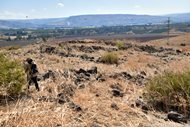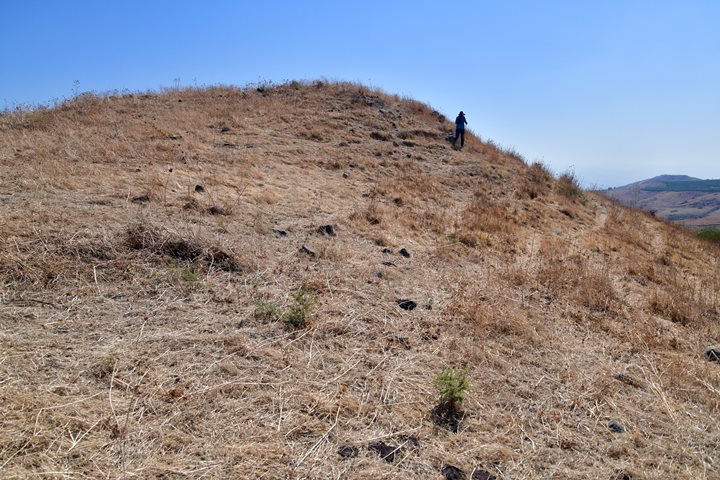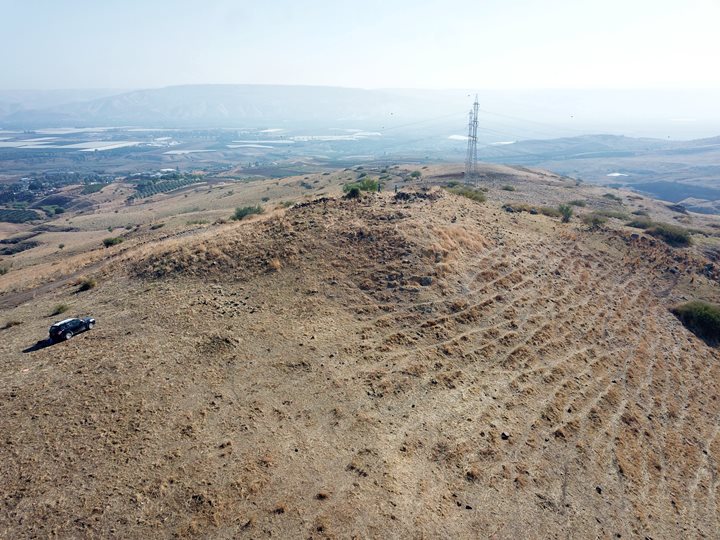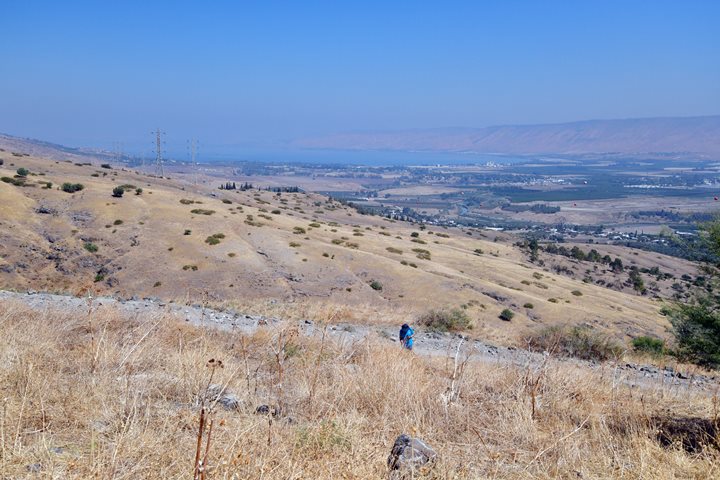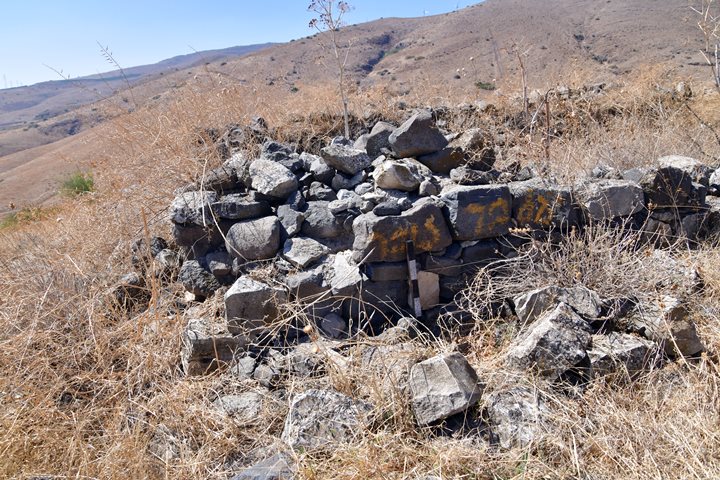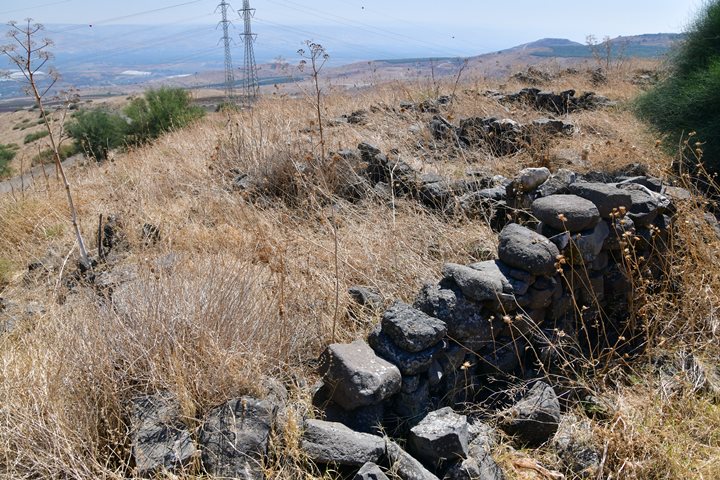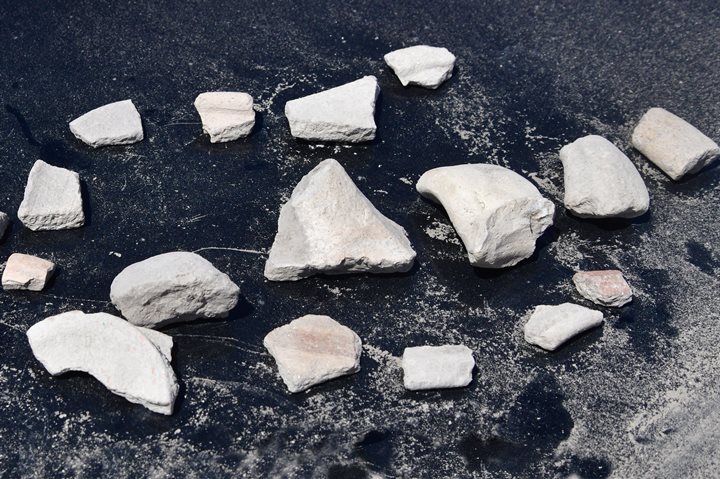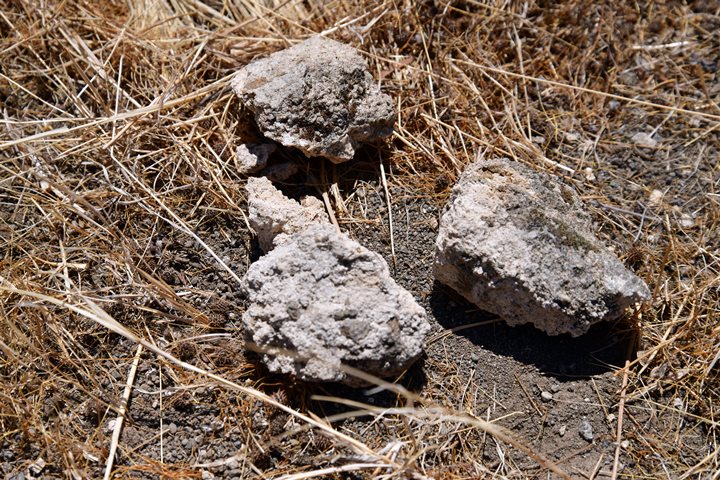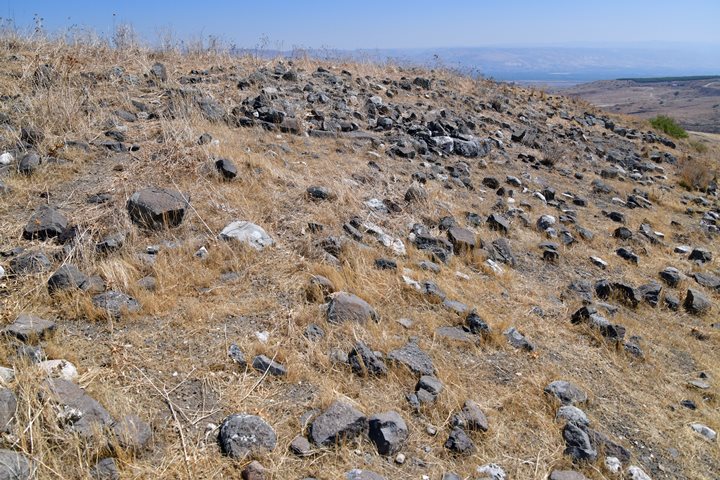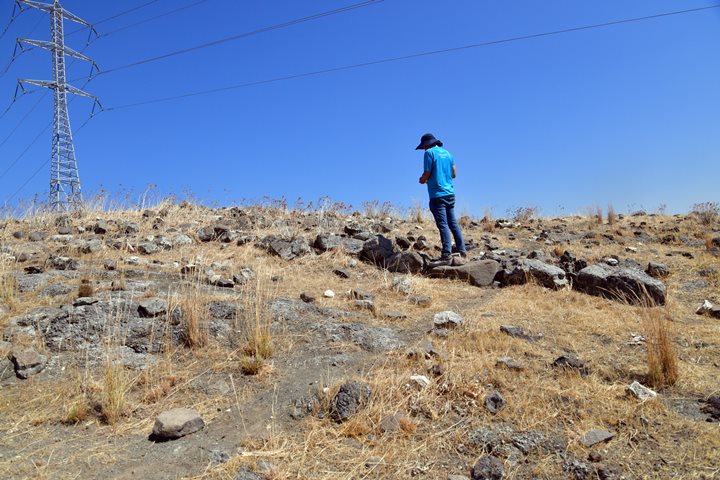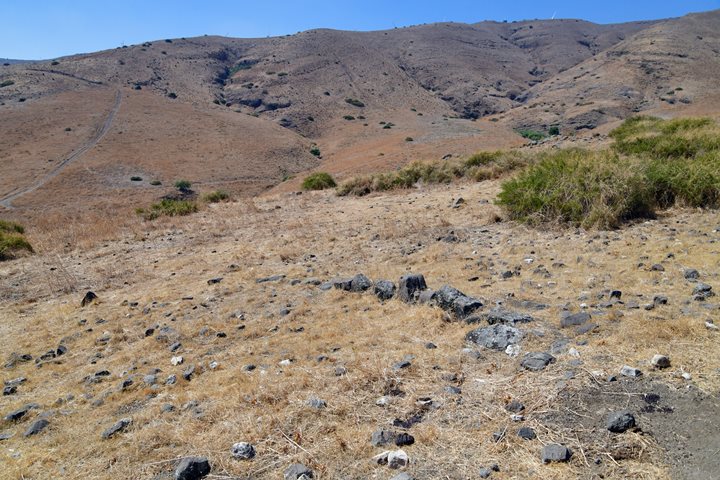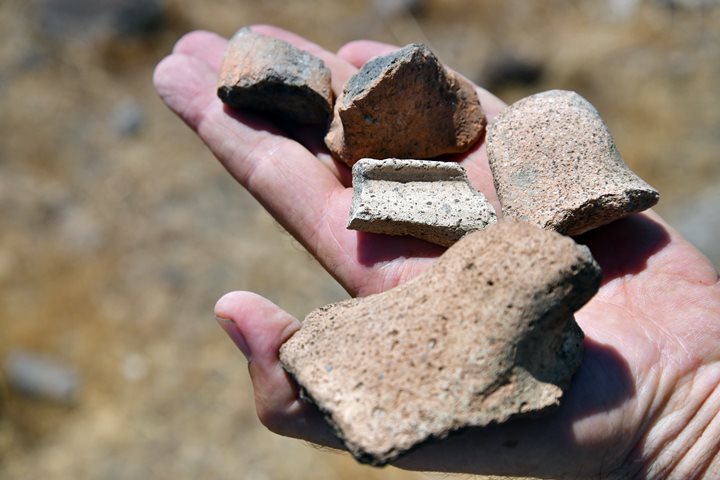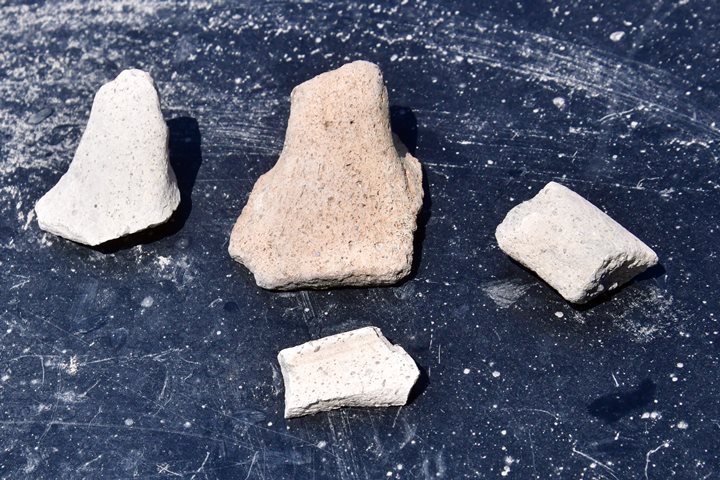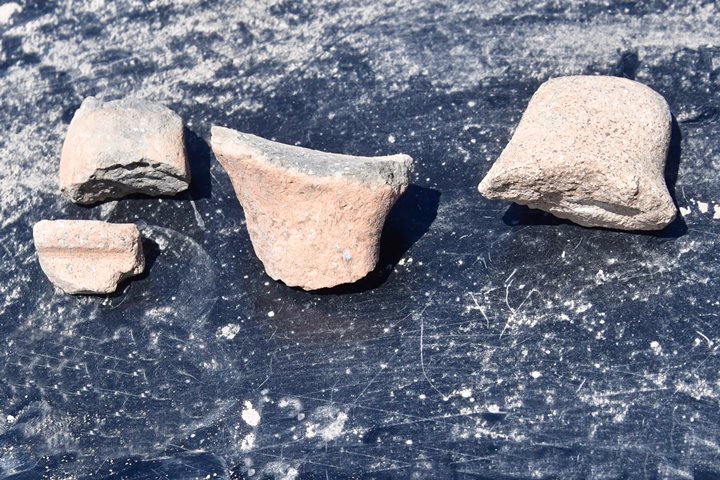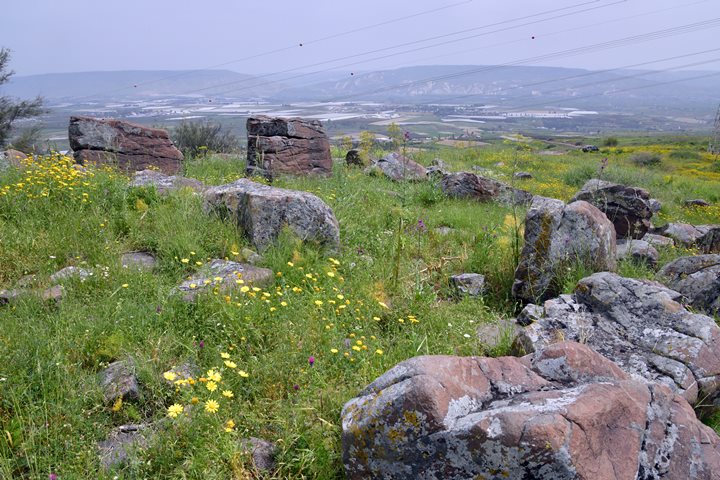Ruins of an Iron Age fortress and a Byzantine period monastery west of Menahemia.
Home > Sites > Jordan Valley> Horvat A-Dir (Khirbet e-Deir)
Contents:
Overview
Aerial Map
History
Photos
* Ascent
* The mound
* Summit
* Casemate walls
* Findings
* South side
Etymology
Links
Background:
On Horvat A-Dir are ruins of an Iron Age fortress, part of a network of fortified settlements that were positioned by the Israelite northern kingdom at strategic locations along major roads. It was later converted to a Byzantine period monastery. On the southern side of the hill are remains of a Bronze/Iron period settlement.
Map / Aerial View:
The aerial map below shows the area around the site, indicating the main points of interest. Horvat A-Dir is located around a mound rising above a ridge, at an altitude of 25m above sea level. Two deep valleys pass on both north and south sides, that are 50-70m lower than the top of the mound. Access to the site is by a dirt road that ascends from the village of Menahemia.
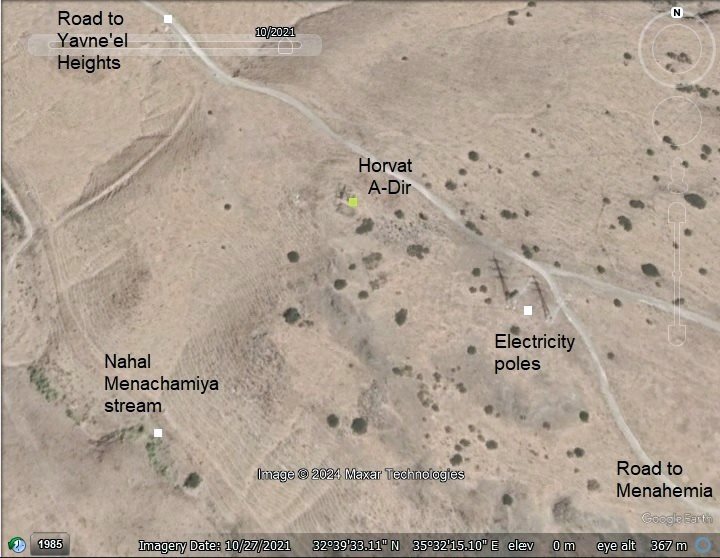
History:
- Bronze period
On the southern side of the site, closer to the valley and the spring on the south, are remains of a Bronze period settlement.
- Iron (Biblical) Age
During the Iron age, a fortress was built on the hill above the valley, guarding an important route. The plan of the settlement was based on casemate walls that were built around a central courtyard. Additional structures were built on the south side of the fortified area.
The site was part of a network of fortified settlements that were positioned by the Israelite northern kingdom at strategic locations along major roads. Horvat Ziwan, a similar Iron age fortress, is 7km south of this site. Horvat Kush, yet another Iron age fortress, is 4km north east of this site. It also guarded an important route ascending from the Jordan valley.
Iron age road:
According to D. Dorsey (“Roads and highways of ancient Israel”, p. 106) a west-east Biblical route passed through the site. The route, designated as “T2”, connected Mount Tabor, through Tel ein Hadda on the Yavne’el heights, descending through Sheikh Muzeighit (Mizpe Elot) and Horvat A-Dir, down to Tell Ubeidiyah road. The road was used for crossing the Jordan river at the ford near Ubediyah, and also for using the Jordan valley route for north and south directions.
The cities and roads during the ancient periods, up to the Roman period, are indicated on the Biblical Map below. The site is marked as a red circle. The ancient west-east route is not indicated here.
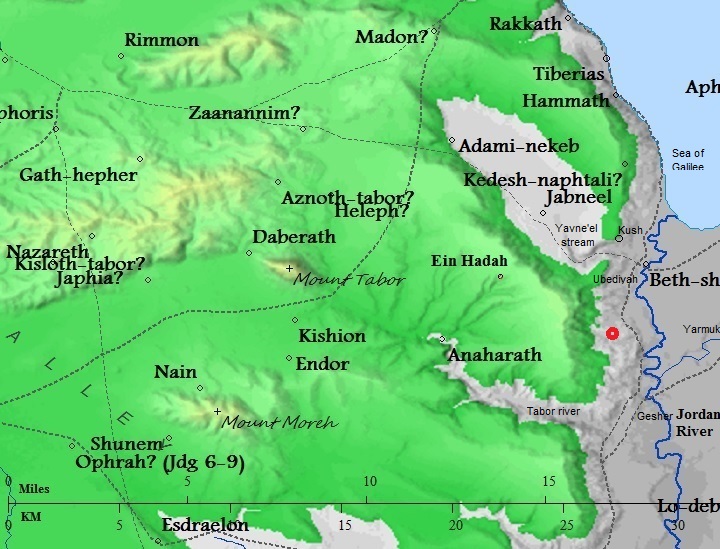
Map of the area – during the Canaanite and Israelite periods (based on Bible Mapper 3.0)
- Israelite period (House of Omri)
According to Finkelstein (“Omride Architecture in Moab: Jahaz and Ataroth”), these fortified settlements were constructed by the Omri House monarchs (Omri, Ahab, Ahaziah, Yoram, and Athaliah, who reigned during the years 885-835 BC). During these years, the arch enemy Aram-Damascus was probably the trigger to construct defense lines along the eastern frontier.
Omri was a general, who was made king (882 BC) over the Northern Kingdom during the mutiny of Zimri (1 kings 16 16): “And the people that were encamped heard say, Zimri hath conspired, and hath also slain the king: wherefore all Israel made Omri, the captain of the host, king over Israel that day in the camp.”. After regaining the control of his Kingdom, Omri turned to defend his country against their arch-enemy – Aram-Damascus – and the rising empire of Assyria.
Ahab, his son, fought against Aram-Damascus in 3 battles, but was killed (850) in the 3rd battle. Ahab’s son Yoram continued to confront the Syrians, and was killed in Jezreel (842), thus ending the house of Omri. (1 kings 22:35): “And the battle increased that day: and the king was stayed up in his chariot against the Syrians, and died at even: and the blood ran out of the wound into the midst of the chariot”.
The assaults continued from the north: the Assyrians forces – a rising force in the region- hit the Northern Kingdom in 841, and Aram-Damascus headed by Hazael invaded in 815-810, as per Biblical accounts (2 Kings 8:12, 12:18-19, 13:3+7; Amos 1:3) and (2 Kings 10 32): “In those days the LORD began to cut Israel short: and Hazael smote them in all the coasts of Israel;”. In one of these intrusions the city of Rechov, the major city in this region, was violently destroyed. The archaeologists dated this destruction to an approximate date 840-830BC. This was probably the fate of the other Iron Age forts in this area.
-
Roman and Byzantine period
During the Byzantine period the Iron age fortress was reused as a monastery. The original casemate chambers were reused as rooms.
-
Ottoman period
The site was examined in the PEF survey (1866-1877) by Wilson, Conder and Kitchener. A section of their map is seen here, with the site marked with a red circle. The site was not reported by the survey team. The site is 3km west of the Dalhamiya Jordan river crossing point, and was on the route of a road that ascended from the river to the Yavne’el heights.
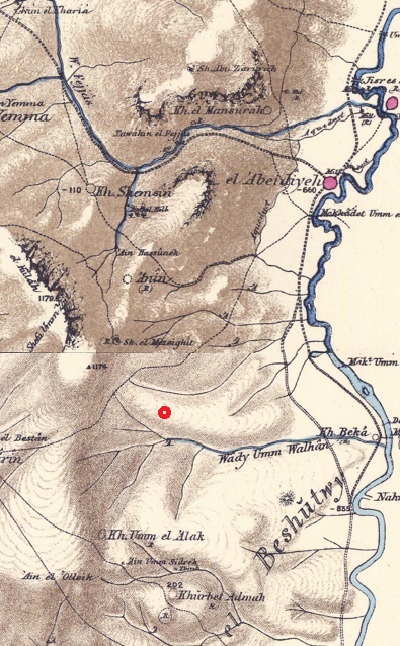
Part of Map sheets 6 & 9 of Survey of Western Palestine,
by Conder and Kitchener, 1872-1877.
(Published 1880, reprinted by LifeintheHolyLand.com)
-
British Mandate
A section of the 1940s British map shows the area around the site, which is seen on the left side as “Kh. ed Deir”. It is located on a ridge between Wady Usbur and Wady el Jurm. Notice that there is a route (a dashed line) that starts in Menahamiya, passes thru the site, continues uphill thru Sheikh esh Muzeighit (Mizpe Elot), and ascends to the Yavne’el heights.
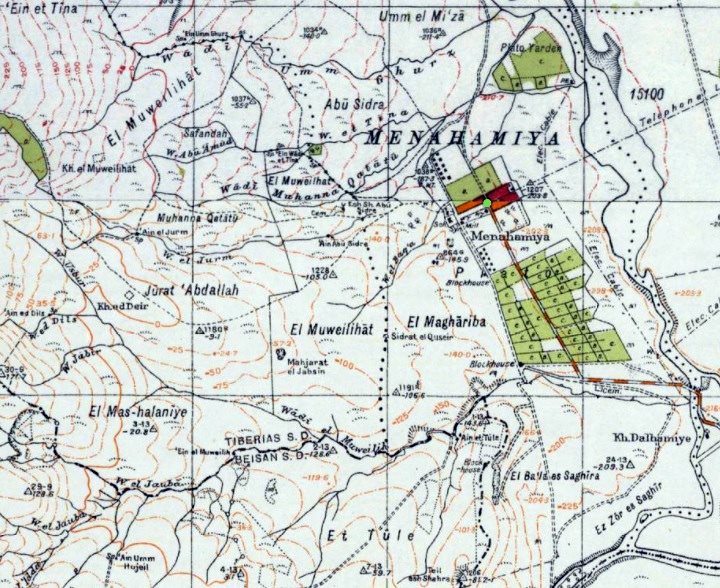
British survey map 1942-1948 – https://palopenmaps.org topo maps
License: public domain under the UK Copyright, Designs and Patent Act 1998
- Modern Period
The site was not yet thoroughly researched. During our visits to the site we attempted to understand its structure and history.
Photos:
(a) The Ascent
The location of the site is on a point in the middle of the ascent to the Yavne’el heights, seen here in the background. The ascent starts from an altitude of -200m (under sea level) and ends on the cliffs above at an altitude of 350m (above sea level).
Click on the photos to view in higher resolution…

(b) The Mound
The fortifications of Horvat A-Dir are located on a mound. This view is from the north-west side.
Another view of the mound is from the west side.
A drone aerial view, captured on November 2024, shows the site from the west side.
The dirt road that ascends to the Yavne’el height passes along the northern foothills, cutting the lower side of the mound.
Another drone photo was captured above the site on December 2024, with a view from the east.
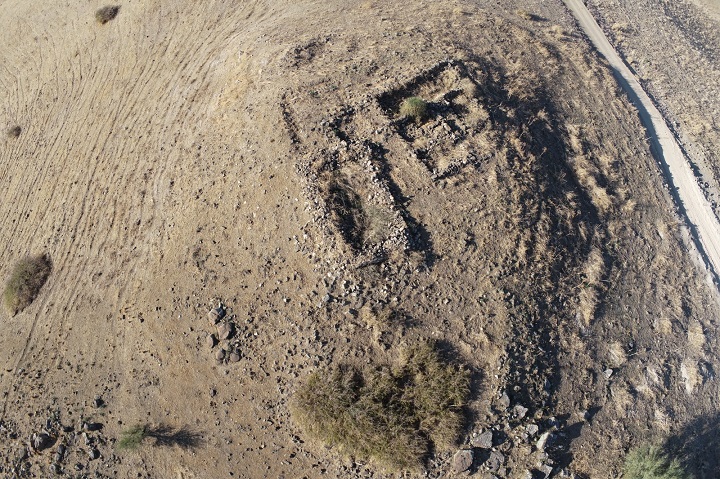
Photo courtesy Ayelet Keidar – part of Academic research by Hebrew university; to be published 2025
(c) Summit
The summit covers an area of 2 dunams. From the top of the mound are great views of the Jordan valley and the Jordan mountains.
This view is towards the north east, with the sea of Galilee seen in the far background.
On the summit are bases of several rectangular structures.
The most preserved wall is on the south east structure.
A closer view of the external side of the wall on the south east structure. About 1m height of the wall was preserved (the archaeological bar stick are with 10cm bars). The wall is composed of black basalt hewn stones with some white limestone stones.
This build is probably dated to the Byzantine period when the Iron Age structure was reused as part of a small monastery.
(d) Casemate chambers
The plan of the fortifications is based on a casemate design, with rectangular chambers surrounding central areas. This view is from the north west side with a view towards the south.
A closer view of this rectangular structure is below. The width of the structure is about 4m.
Notice that there is a lower wall in the middle of the length.
A northern view from the other side of this structure.
Bases of other structures surround the summit and built in the center of the enclosed area.
(e) Findings
According to Zvi Gal’s survey (“Lower Galilee During the Iron Age”, site 3.5) the ceramics were dated to the Middle Bronze II period (20%), Late Bronze and Iron Age I (15%), Iron Age II (20%), and Byzantine (45%).
The majority of ceramics we found during our short survey were of the Iron age I and II, probably 80% of the pottery remains. These are seen in the following photo. Additional group of pottery fragments were of the Byzantine period (20%).
An example of a Byzantine period sherd is this handle with a red cross painted on it. It is a rare finding.
There are also many fragments of sun dried mud bricks. During the Iron age the sun dried mud bricks were laid over the base of the basalt stones to construct the walls.
Most of the bricks were observed along a lower height around the summit.
(f) South side
On the southern foothills are remains of a Bronze period settlement or an industrial section associated with the Iron Age fortress.
The entire area of several dunams are covered with basalt stones, with sections of walls.
A example of a wall is seen below. There are also several large rectangular compounds surrounded by bases of walls.
As seen in this photo, twin electrical poles, carrying high voltage lines, rise above the south side of the southern foothills.
On a lower side of this area, seen below, is a wall built in a semi circular pattern.
Notice a green area in the valley below (Menahemia stream valley). This was probably a spring that provided water to the settlement.
All the pottery remains we observed were of the Bronze, Iron 1 and Iron II periods.
A closer view of the Bronze or Iron 1 period ceramic fragments:
A closer view of the Iron 2 period ceramic fragments:
(g) Nature views
During the winter of 2024, after a unique rainy season, the weeds grew wild all over the area. We visited the site on March 2024 and here are some of the sights.
First, a rock garden on the southern side of the mound. These large basalt rocks are natural, and we did not see any ancient findings when we returned during the summer time.
Second – a lovely west view of the southern foothills. All green, covered with wild flowers.
Etymology – behind the name:
* The name of the site:
- Kh. ed Deir – Arabic: “Ruin of the monastery”
- Horvat A-Dir – Hebrew modern name, based on the Arabic name. Adir means ‘great’.
* Other names:
- Menahemia – The village was established in 1901 (the first Jewish settlement in the Jordan valley).
Links and references:
* External links:
- Horvat a-Dir – Field survey – Biblewalks survey, 11:15 minutes, Nov 2024
-
Hiking to the basalt canyon of Wady el Jurm Menahamiya (Hebrew)
-
“Omride Architecture in Moab: Jahaz and Ataroth.” Eretz-Israel: Archaeological, Historical and Geographical Studies.
* Internal links:
- Horvat Ziwan – A similar Iron age fortress, 7km south of this site
- Horvat Kush, another similar Iron age fortress, is 4km north east of this site.
- Mizpe Elot (esh Sheikh Muzeighit)
- Jordan valley survey
- Sun dried mud bricks
BibleWalks.com – walks along the Jordan river
Horvat Kush<<<—previous site—<<<All Sites>>>—next Jordan Valley site—>>>Mizpe Elot
This page was last updated on Jan 18, 2025 (add photo)
Sponsored Links:
